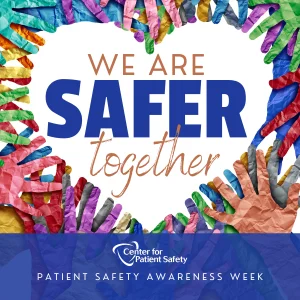Mar
08

Posted by fsteele on March 8th, 2024
Posted in: Uncategorized
March 10 – 16th is Patient Safety Awareness Week. Patient safety and safety concerns touch nearly all aspects of healthcare. Safety incidents ranging from diagnostic delay to medication errors to healthcare-associated infections to communication failures and more appear throughout the biomedical literature and in healthcare professionals’ discussions.
throughout the biomedical literature and in healthcare professionals’ discussions.
Over twenty years ago, the Institute of Medicine released a report estimating that between 44,000 and 98,000 people in the United States die each year due to medical errors.1 More recent estimates for the burden of medical errors are controversial due to the difficulties in accurately identifying safety events in large datasets, although estimates of somewhat over 200,000 preventable deaths annually are common.2 Additionally, it is important to note that patient safety events can result in a wide range of morbidity (some are so minor as to not affect a patient’s outcome), and relatively few cause death, so the total number of errors that occur is much higher than any mortality estimate.
While eliminating all human error in medical care is impossible, progress can be made. Patient safety events are more often attributable to systems breakdowns, such as unclear responsibilities, incomplete medical records, or equipment problems, than to willful provider wrongdoing. As such, improvements to systems-level things like workflows and hospital spaces can make a difference for patient safety. The Institute of Medicine’s 1999 report advocated for a systems-based approach to patient safety, and this remains the focus of research and advocacy related to healthcare quality. And progress has been made—for example, a patient’s risk of a healthcare-associated infection decreased 16% from 2011 to 2015.3
Information professionals can support health systems’ and healthcare providers’ patient safety and quality improvement efforts. At the individual provider level, evidence-based information is key to good clinical decision-making in complex, unfamiliar situations. In some healthcare settings, librarians are able provide real-time, point-of-need clinical information to physicians and other providers, either by participating in rounds or through services embedded into the electronic health record.4,5 However, such services require both a significant investment of library staff time and buy-in from providers, so they aren’t feasible for all health sciences libraries to provide. A less resource-intensive way for librarians to support clinical decision-making is to spread awareness of and provide training for any point-of-care tools available to the providers at their institution, such as UpToDate for general evidence-based medicine support or Lexicomp for drug information.
At a more systems-based level, librarians can provide literature searches and article retrieval services for quality improvement projects and/or morbidity and mortality cases. There is a vast amount of patient safety research and discussion in the biomedical literature, and librarians are excellent resources to help administrators, physicians, nurses, and other stakeholders find data on previous patient safety work and the costs, implementation strategies, and outcomes that can be expected with various projects.
The National Library of Medicine’s PubMed database is an excellent resource to search for patient safety research. PubMed contains over 36 million citations and can be used to search for information from medicine, nursing, pharmacy, health policy, and other health professions involved in patient safety and quality improvement work. Most of PubMed’s citations are from scientific journals, but reports from government agencies involved in patient safety, such as the Agency for Healthcare Research and Quality, are also discoverable in the database.
PubMed Central (PMC) is a closely related resource from the National Library of Medicine. Many articles that can be found searching PubMed can be accessed in full from PubMed Central. Patient safety research funded by the National Institutes of Health is available in PMC as a funding requirement, and several patient safety and quality improvement-focused journals, including BMJ Open Quality, Patient Safety in Surgery, and Pediatric Quality & Safety, are fully accessible in PubMed Central.
Although patient safety is in the spotlight this week, the National Library of Medicine and information professionals can be valuable partners in patient safety work all year long.
Sources
1Institute of Medicine Committee on Quality of Health Care in America. To Err Is Human: Building a Safer Health System. National Academies Press; 2000. Available from https://www.ncbi.nlm.nih.gov/books/NBK225182/
2Kavanagh KT, Saman DM, Bartel R, Westerman K. Estimating hospital-related deaths due to medical error: A perspective from patient advocates. J Patient Saf. 2017;13(1):1-5. https://doi.org/10.1097/pts.0000000000000364
3Magill SS, O’Leary E, Janelle SJ, Thompson DL, Dumyati G, Nadle J, Wilson LE, Kainer MA, Lynfield R, Greissman S, Ray SM, Beldavs Z, Gross C, Bamberg W, Sievers M, Concannon C, Buhr N, Warnke L, Maloney M, Ocampo V, Brooks J, Oyewumi T, Sharmin S, Richards K, Rainbow J, Samper M, Hancock EB, Leaptrot D, Scalise E, Badrun F, Phelps R, Edwards JR, for the Emerging Infections Program Hospital Prevalence Survey Team. Changes n prevalence of health care-associated infections in U.S. hospitals. N Engl J Med. 2018;379(18):1732-1744. https://doi.org/10.1056/NEJMoa1801550
4Burgard DE, Kenny T. Doctors, nurses… and a librarian? Hospital librarians improving Texans’ health every day. Texas Libr J. 2018;94(4):8-10.
5Lake E, Steidinger S. Embedding library support into the electronic health record: Key considerations when developing a new service. J Hosp Libr. 20https://nvrh.org/patient-safety-awareness-week-2024/20;20(1):56-63. https://doi.org/10.1080/15323269.2020.1705148
This post was written by Gina Genova, Clinical Librarian and Assistant Professor, Kornhauser Health Sciences Library, University of Louisville